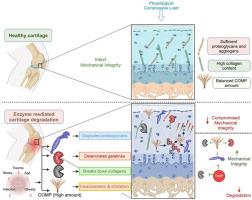Therapeutic potential of COMP and TIMP-3 in preserving cartilage integrity compromised by proteases: A histo-mechanical study
IF 3.5
2区 医学
Q2 ENGINEERING, BIOMEDICAL
Journal of the Mechanical Behavior of Biomedical Materials
Pub Date : 2025-09-02
DOI:10.1016/j.jmbbm.2025.107183
引用次数: 0
Abstract
Matrix metalloproteinases (MMPs) and a disintegrin and metalloproteinase with thrombospondin motifs (ADAMTS) significantly impact articular cartilage biomechanical properties in osteoarthritis (OA). However, comprehensive understanding of biomechanical responses and the efficacy of potential therapeutic interventions remains limited. This study investigates how MMPs and ADAMTS synergistically degenerate cartilage biomechanical properties under different loading conditions, and evaluates the preventive role of cartilage oligomeric matrix protein (COMP) and tissue inhibitor of metalloproteinase-3 (TIMP-3). Bovine tibiofemoral cartilage disks (N = 80) with subchondral bone from 8 cows were harvested and incubated with MMP-9, MMP-13, ADAMTS-5, COMP, and TIMP-3 in four distinct combinations: Group A (MMP-9+MMP-13+ADAMTS-5), Group B (Group A + COMP), Group C (Group A + TIMP-3), Group D (Group B + TIMP-3) and Group E (negative control). Comprehensive biomechanical assessment included indentation, unconfined compression, and dynamic testing to simulate various physiological activities. Safranin O and Picrosirius red staining were used for histological analysis. Group A demonstrates reduced Young's modulus , instantaneous modulus , and equilibrium modulus compared to controls. Adding COMP substantially improved Young's modulus and equilibrium modulus relative to Group A. Supplementation with TIMP-3 exhibited significant improvements in strain-dependent instantaneous modulus and dynamic modulus by and respectively. Histological assessment confirmed improvement in proteoglycan and collagen preservation across treatment groups. This study suggests that COMP helps preserve cartilage mechanical integrity by indirectly protecting cartilage from all the applied proteases, while TIMP-3 provides substantial additional protection through direct inhibition of MMP-13 and ADAMTS-5. The investigations suggest activity-specific recommendations for OA management and provide valuable insights into developing targeted OA interventions.

COMP和TIMP-3在保护受蛋白酶损害的软骨完整性方面的治疗潜力:一项组织力学研究
基质金属蛋白酶(MMPs)和具有血小板反应蛋白基序的崩解素和金属蛋白酶(ADAMTS)显著影响骨关节炎(OA)的关节软骨生物力学特性。然而,对生物力学反应和潜在治疗干预效果的全面理解仍然有限。本研究探讨了不同载荷条件下MMPs和ADAMTS如何协同退化软骨生物力学性能,并评估了软骨寡聚基质蛋白(COMP)和组织金属蛋白酶-3抑制剂(TIMP-3)的预防作用。取8头牛软骨下骨的牛胫股软骨盘(N = 80),分别与MMP-9、MMP-13、ADAMTS-5、COMP和TIMP-3以4种不同的组合进行孵育:A组(MMP-9+MMP-13+ADAMTS-5)、B组(A组+ COMP)、C组(A组+ TIMP-3)、D组(B组+ TIMP-3)和E组(阴性对照)。综合生物力学评估包括压痕、无侧限压缩和动态测试,以模拟各种生理活动。采用红花素O和小天狼星红染色进行组织学分析。与对照组相比,A组杨氏模量降低了71.7%(95%可信区间(CI):[64.3%,85.2%]),瞬时模量降低了71.4%(95%CI:[50.0%,83.6%]),平衡模量降低了61.7%(95%CI:[24.6%,80.6%])。与a组相比,添加COMP可显著提高杨氏模量41.4%(95%CI:[9.9%,102.2%])和平衡模量18.9%(95%CI:[−31.9%,107.8%])。添加TIMP-3可显著提高应变相关瞬时模量和动态模量,分别提高235.5%(95%CI:[117.7%,417.9%])和178.6%(95%CI:[100.4%,296.3%])。组织学评估证实,各治疗组的蛋白多糖和胶原蛋白保存均有改善。该研究表明,COMP通过间接保护软骨免受所有应用蛋白酶的侵害,有助于保持软骨的机械完整性,而TIMP-3通过直接抑制MMP-13和ADAMTS-5提供实质性的额外保护。这些调查为OA管理提出了具体的建议,并为制定有针对性的OA干预措施提供了宝贵的见解。
本文章由计算机程序翻译,如有差异,请以英文原文为准。
求助全文
约1分钟内获得全文
求助全文
来源期刊

Journal of the Mechanical Behavior of Biomedical Materials
工程技术-材料科学:生物材料
CiteScore
7.20
自引率
7.70%
发文量
505
审稿时长
46 days
期刊介绍:
The Journal of the Mechanical Behavior of Biomedical Materials is concerned with the mechanical deformation, damage and failure under applied forces, of biological material (at the tissue, cellular and molecular levels) and of biomaterials, i.e. those materials which are designed to mimic or replace biological materials.
The primary focus of the journal is the synthesis of materials science, biology, and medical and dental science. Reports of fundamental scientific investigations are welcome, as are articles concerned with the practical application of materials in medical devices. Both experimental and theoretical work is of interest; theoretical papers will normally include comparison of predictions with experimental data, though we recognize that this may not always be appropriate. The journal also publishes technical notes concerned with emerging experimental or theoretical techniques, letters to the editor and, by invitation, review articles and papers describing existing techniques for the benefit of an interdisciplinary readership.
 求助内容:
求助内容: 应助结果提醒方式:
应助结果提醒方式:


